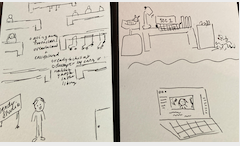Sense of Place and Belonging: Lessons from the Pandemic
DOI:
https://doi.org/10.20343/teachlearninqu.10.34Keywords:
pandemic learning, remote learning, in-person learning, higher education, communities of practiceAbstract
This study investigates how students experienced a sense of place and a sense of belonging in both in-person and virtual learning environments by analyzing student interview data. As educators and university students grapple with the ongoing COVID-19 pandemic, we consider how students experience the presence and absence of sense of place and belonging, and how this could inform faculty and staff practices. We conclude by offering recommendations for university educators, with a particular focus on the benefits of building communities of practice.
Downloads
References
Adler-Kassner, Linda, John Majewski, and Damian Koshnick. 2012. “The Value of Troublesome Knowledge: Transfer and Threshold Concepts in Writing and History.” In Composition Forum 26, np. http://compositionforum.com/issue/26/troublesome-knowledge-threshold.php.
Adler-Kassner, Linda, and Elizabeth Wardle. 2015. Naming What We Know: Threshold
Concepts of Writing Studies. Boulder: University Press of Colorado.
Adler-Kassner, Linda, Ilene Clark, Liane Robertson, Kar Taczak, and Kathleen B. Yancey. 2016. “Assembling Knowledge: The Role of Threshold Concepts in Facilitating Transfer.” In Critical Transitions: Writing and the Question of Transfer, edited by Chris M. Anson and Jessie L. Moore. 17–47. Boulder: University Press of Colorado.
Agnew, John. 1987. The United States in the World-Economy: A Regional Geography. Cambridge: Cambridge University Press.
Blair, Erik. 2013. “The Challenge of Contextualising the Scholarship of Teaching and Learning.” Teaching & Learning Inquiry 1 (1): 127–30. https://doi.org/10.2979/teachlearninqu.1.1.127.
Carpenter, Cathryn, and Nevin Harper. 2015. “Health and Wellbeing Benefits of Activities in the Outdoors.” In Routledge International Handbook of Outdoor Studies, edited by Barbara Humberstone, Heather Prince, and Karla A. Henderson. 5968. New York: Routledge.
Hounsell, Dai, and Charles Anderson. 2009. “Ways of Thinking and Practicing in Biology and History: Disciplinary Aspects of Teaching and Learning Environments.” In The University and its Disciplines: Teaching and Learning Within and Beyond Disciplinary Boundaries, edited by Carolin Kreber. 71–83. New York: Routledge.
Iverson, Joel O. 2010. “Knowledge, Belonging, and Communities of Practice.” In Communication and Organizational Knowledge: Contemporary Issues for Theory and Practice, edited by Heather E. Canary and Robert D. McPhee. 45–52. New York: Routledge.
Johnson, Christopher M. 2001. “A Survey of Current Research on Online Communities of Practice.” The Internet and Higher Education 4 (1): 45–60. https://doi.org/10.1016/S1096-7516(01)00047-1.
Jorgensen, Bradley S., and Richard C. Stedman. 2011. “Measuring the Spatial Component of Sense of Place: A Methodology for Research on the Spatial Dynamics of Psychological Experiences of Places.” Environment and Planning B: Planning and Design 38 (5): 795–813. https://doi.org/10.1068/b37054.
Kirschner, Paul A., and Kwok‐Wing Lai. 2007. “Online Communities of Practice in Education.” Technology, Pedagogy and Education 16 (2): 127–31. https://doi.org/10.1080/14759390701406737.
Lerner, Neal. 2016. “Writing is a Way of Enacting Disciplinarity.” In Naming What We Know: Threshold Concepts of Writing Studies, edited by Linda Adler-Kassner and Elizabeth Wardle, 40–41. Logan: Utah State University Press.
McCunn, Lindsay J., and Robert Gifford. 2018. “Spatial Navigation and Place Imageability in Sense of Place.” Cities 74: 208–18. https://doi.org/10.1016/j.cities.2017.12.006.
Mehdipour, Yousef, and Hamideh Zerehkafi. 2013. “Mobile Learning for Education: Benefits and Challenges.” International Journal of Computational Engineering Research 3 (6): 93–101. http://www.ijceronline.com/papers/Vol3_issue6/part%203/P03630930100.pdf.
Ngo, Minh, and Michael Brklacich. 2014. “New Farmers’ Efforts to Create a Sense of Place in Rural Communities: Insights from Southern Ontario, Canada.” Agriculture and Human Values 31: 53–67. https://doi.org/10.1007/s10460-013-9447-5.
Nunn, Lisa M. 2021. College Belonging: How First-Year and First-Generation Students Navigate Campus Life. New Brunswick: Rutgers University Press.
Patton Davis, Lori, and Samuel Museus. 2019. “What Is Deficit Thinking? An Analysis of Conceptualizations of Deficit Thinking and Implications for Scholarly Research.” NCID Currents 1 (1). http://dx.doi.org/10.3998/currents.17387731.0001.110.
Strayhorn, Terrell L. 2018. College Students’ Sense of Belonging: A Key to Educational Success for All Students. New York: Routledge.
Thomas, M’Balia, and Marta Carvajal-Regidor. 2021. “From ‘Slow’ to ‘Being “Lazy” and Slowing Down’” and the Impact on Student Learning.” Teaching & Learning Inquiry 9, (2): 1–14. http://dx.doi.org/10.20343/teachlearninqu.9.2.12.
Twohig-Bennett, Caoimhe, and Andy Jones. 2018. “The Health Benefits of the Great Outdoors:
A Systematic Review and Meta-Analysis of Greenspace Exposure and Health Outcomes.” Environmental Research 166: 628–37. https://doi.org/10.1016/j.envres.2018.06.030.
Wenger, Etienne. 1998. “Communities of Practice: Learning as a Social System.” The Systems Thinker 9 (5): 1–8.
Williams, Daniel R., and Susan I. Stewart. 1998. “Sense of Place: An Elusive Concept That is Finding a Home in Ecosystem Management.” Journal of Forestry 96 (5): 18–23. https://doi.org/10.1016/j.envres.2018.06.030.

Downloads
Published
How to Cite
Issue
Section
License
Copyright (c) 2022 Linda Adler-Kassner, Margarita Safronova, Yasmine Dominguez-Whitehead, Karen Gonzalez, Stephanie Nguyen, Malaphone Phommasa

This work is licensed under a Creative Commons Attribution-NonCommercial 4.0 International License.


